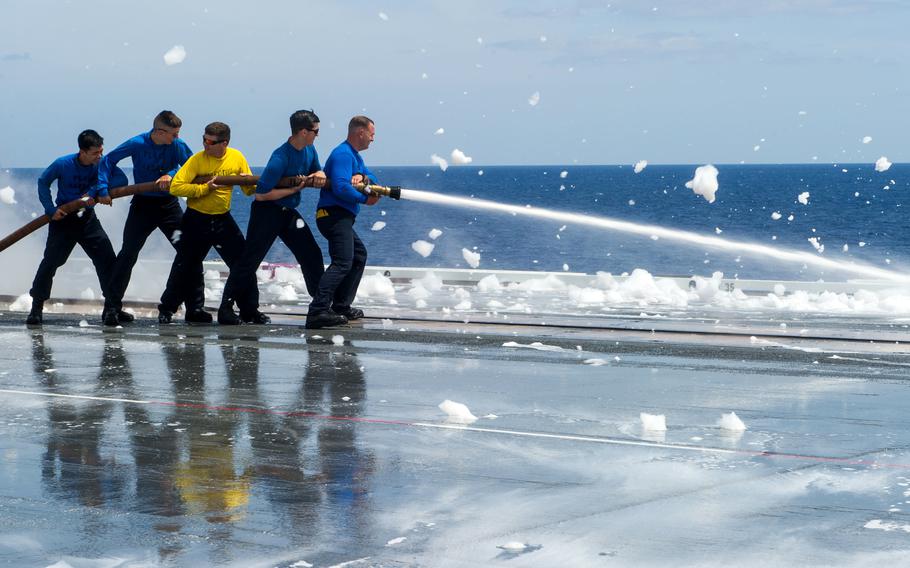
Sailors use aqueous film forming foam aboard the aircraft carrier USS Ronald Reagan during sea trials in wates south of Japan, May 12, 2018. (Kenneth Abbate/U.S. Navy)
TOKYO — The U.S. military is moving to rid three Army installations on Okinawa of fire-suppressant foam that contains toxic PFAS compounds – “forever chemicals” suspected of causing serious health problems.
The three sites — tank farms where fuel and lubricants are stored — are among the last U.S. military installations in Japan where the foam systems remain in place.
The Defense Department has removed the firefighting foam from all its Navy and Marine Corps bases in Japan and from all Army bases and Misawa Air Base on Honshu, the largest of the country’s four main islands, according to a news release from U.S. Forces Japan on Thursday.
It has replaced “legacy AFFF,” meaning aqueous film forming foam, with new formulations that do not contain PFOS and PFOA, component chemicals in PFAS. After removal, the toxic foam was incinerated at licensed disposal facilities in Japan, according to USFJ.
Yokota Air Base, an airlift hub in western Tokyo, and Kadena Air Base, a premier fighter base on Okinawa, still have legacy systems in place, according to a Friday email from Air Force Maj. Tom Barger, a spokesman for U.S. Forces Japan.
“The process has started and significant progress made,” he said. “It is just not yet fully complete.”
The replacement process thus far has taken more than three years and was delayed by the COVID-19 pandemic, Barger said.
The U.S. will soon begin replacing PFAS foam at three Army installations on Okinawa where petroleum, oil and lubricants are stored, according to USFJ’s release. The work should be finished in fiscal year 2024.
The command identified those sites as tank farms at Chimuwan, Kuwae and White Beach. The systems are already deactivated, and water-based systems will eventually replace the foam, USFJ said.
PFAS — manmade per-and polyfluoroalkyl substances — is used to make coatings and products that resist heat, oil, stains, grease and water, according to the Centers for Disease Control and Prevention.
Studies show an increased risk of cancer and other adverse health effects from exposure to these substances, according to the U.S. Environmental Protection Agency. A major U.S. manufacturer, 3M, announced Dec. 20 it will stop using PFAS by the end of 2025.
PFAS detected in water in and around bases in Japan frequently puts Japanese authorities at odds with the U.S. military. The chemicals have turned up in wastewater treatment plants on military bases and in local streams or groundwater near Misawa Air Base, Naval Air Facility Atsugi, Yokota Air Base and Marine Corps Air Station Futenma.
In some cases, the link between a nearby U.S. base and water tainted by PFAS chemicals is not certain. In others, there is a direct tie to an on-base leak.
In January 2022, a cracked pipe at a hardened aircraft shelter at Misawa released water through a fire-suppression system where the foam was previously kept. The air base and Japanese authorities tracked PFAS in wastewater on the base until they were satisfied no further measures were required.
On Sept. 23, heavy rain at NAF Atsugi caused a hangar control panel to malfunction, resulting in the release of PFAS into a small stream that runs through the base, Japanese officials in Kanagawa prefecture reported at the time.
On Sept. 29, Yokosuka Naval Base detected high concentrations of PFOA in its industrial wastewater, according to Yokosuka city authorities at the time. The Navy also found high levels of the chemical in the base wastewater in May.
At Yokosuka and Atsugi, the Navy removed the toxic firefighting foam and some equipment containing it after the contamination was discovered.
The Marine Corps removed its PFAS-based firefighting foam in 2021 after a spill at MCAS Futenma in 2019.
Yokota, where USFJ is headquartered, plans to remove its toxic firefighting foam “over the next few years,” base spokesman 1st Lt. Danny Rangel told Stars and Stripes in February.
The Japan Self-Defense Forces is also replacing the toxic foam at its facilities at Misawa, NAF Atsugi and Marine Corps Air Station Iwakuni, south of Hiroshima, according to the release.